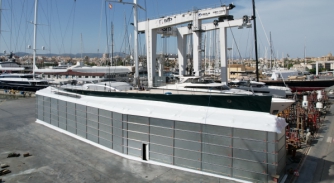AkzoNobel reminds industry of challenges with ceramic coatings
The aim is to improve understanding of the end-of-lifecycle management of ceramic treatments on superyachts…
The number of superyachts receiving partial or full ceramic treatments has increased significantly in recent years as a way of extending the serviceable life of paint systems on board. When not removed effectively, however, ceramic treatments can cause contamination that is not compatible with high performance aesthetic finishes. These issues are often not discussed upfront, which has resulted in challenges when the time comes for the yacht to be repainted.
Despite guidelines surrounding the use and removal of ceramic coatings on yachts published in 2020 by the International Council of Marine Industry Associations (ICOMIA), AkzoNobel has seen a significant spike in queries from its customers – most of which are covered within the ICOMIA document. This lack of awareness that the guidelines exist has prompted AkzoNobel to release a technical update on the topic.
“In light of the many recent questions and challenges that have arisen, we thought it an opportune time to recommunicate the existing information presented in the original ICOMIA document,” explains Gareth Thomas, technical support team manager at AkzoNobel. “As more and more yachts have had ceramic coatings applied, we’re now starting to encounter the challenges associated with the end of their lifecycle.”
The original guidelines were set in motion in 2018 when ICOMIA was made aware by its members of the increasing challenges surrounding the use of ceramic coatings on large yachts. ICOMIA members, consisting of coating manufacturers, shipyards, paint inspectors and management companies, voiced that the industry was suffering from numerous difficulties with respect to repainting large yacht refits due to insufficiently or incorrectly removed ceramic treatments.
ICOMIA then established a workgroup, made up of representatives from coating manufacturers, ceramic treatment application companies and paint inspectors, to collaboratively develop industry-specific guidelines surrounding the use of ceramic treatments. Representatives from AkzoNobel were instrumental in compiling this informative document. “We were surprised that many of the main ceramic coatings suppliers were frustrated with the lack of understanding of some in their sector and, as such, were very willing to engage and help educate the industry,” remembers Thomas. “In fact, there was a huge amount of information already available that was shared by the different parties.”
As testing conducted by the yacht R&D team at AkzoNobel has demonstrated a clear link between commonly observed effects in paint refits (such as fisheyes, dimples and pinholes) and the types of PDMS (polydimethylsiloxane) that exists in ceramic coatings, AkzoNobel is understandably keen to help find solutions to the challenges that removal of these ceramic coatings present. As such, the company has carried out further research around the thorough removal of ceramic treatments, as well as testing for its presence.
“Some ceramic coatings suppliers recommend sanding to remove the product, but our research has found that it’s almost impossible to remove by sanding,” continues Thomas. “What’s worse is that contaminated sanding dust can result in cross-contamination of equipment and surfaces and is almost impossible to remove from the application environment, which then directly results in defects during the application of subsequent aesthetic finishes. So, we have been focusing on how to test if it’s been correctly removed before any paint is applied.”
Often, paint applicators and refit yards aren’t even aware that ceramic treatments are present on a yacht until they apply the final finish, at which point it’s too late. “It’s no one’s fault as such; if there are crew changeovers or new ownership in place, there’s no documentation to indicate what ceramic treatments have been applied and who you need to contact to remove it,” advises Thomas.
Considering this, AkzoNobel encourages shipyards and paint applicators to ask about existing ceramic treatments as one of the first questions when a yacht books in for a refit, as it may significantly impact the timescale and cost of the project. It is also important for the vessel operators, whether it's the captains or the management companies, to be aware of the issue. “These treatments do have a place, but they need to come with the understanding that the next refit cycle will involve some additional work and cost to remove them,” adds Thomas. “If it were easy to remove, it wouldn’t do its job of being a hard, abrasion-resistant coating.”
That said, the main challenge facing the sector is to identify the correct and thorough procedure for the removal of ceramic treatments. And, depending on what type of product has been used, there are different recommended removal processes. AkzoNobel advises that whatever company applied the product should be contracted to remove it because they should know the correct procedure to follow.
Beyond this latest technical update, AkzoNobel aims to continue to share technical information that is easy to understand, in the form of whitepapers. “We have a large R&D team doing some fantastic work behind the scenes who are constantly learning about coatings and new systems and technologies around applications,” concludes Matthew Anzardo, global segment manager at AkzoNobel. “We are happy to share the knowledge and expertise that we’ve built up over time so that owners can enjoy their yachts. The onus is on the operator though to ensure they are aware of what’s already on the yacht before looking at a refit procedure, and ensuring that processes followed are suitable and will be compatible with the next coating.”
Profile links
NEW: Sign up for SuperyachtNewsweek!
Get the latest weekly news, in-depth reports, intelligence, and strategic insights, delivered directly from The Superyacht Group's editors and market analysts.
Stay at the forefront of the superyacht industry with SuperyachtNewsweek
Click here to become part of The Superyacht Group community, and join us in our mission to make this industry accessible to all, and prosperous for the long-term. We are offering access to the superyacht industry’s most comprehensive and longstanding archive of business-critical information, as well as a comprehensive, real-time superyacht fleet database, for just £10 per month, because we are One Industry with One Mission. Sign up here.
Related news

AkzoNobel publish financial results for second quarter 2022
Revenue is up 14 per cent despite lockdowns in China and destocking in EMEA DIY channels
Business

Sustainable solution for refit sector gains traction
We speak with the Captain of 45m S/Y Saudade after they saved 2000kg of plastic on a refit project in STP
Technology

Where is the refit sector going?
What can refit yards really do to become future-proof and stand out against their competitors?
Opinion
Related news
Where is the refit sector going?
3 years ago
NEW: Sign up for
SuperyachtNewsweek!
Get the latest weekly news, in-depth reports, intelligence, and strategic insights, delivered directly from The Superyacht Group's editors and market analysts.
Stay at the forefront of the superyacht industry with SuperyachtNewsweek



